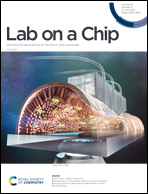Strain-induced recognition of molecular and chirality in cholesteric liquid crystal droplets for distance and curvature sensing†
Abstract
Chirality is universal in nature and in biological systems, and the chirality of cholesteric liquid crystals (Ch-LC) is both controllable and quantifiable. Herein, a strategy for precise chirality recognition in a nematic LC host within soft microscale confined droplets is reported. This approach facilitates applications in distance and curvature sensing as well as on-site characterization of the overall uniformity and bending movements of a flexible device. Due to interfacial parallel anchoring, monodisperse Ch-LC spherical microdroplets show radial spherical structure (RSS) rings with a central radical point-defect hedgehog core. Strain-induced droplet deformation destabilizes the RSS configuration and induces the recognition of chirality, creating “core–shell” structures with distinguishable sizes and colors. In practice, an optical sensor is achieved due to the rich palette of optically active structures that can be utilized for gap distance measuring and the monitoring of curvature bending. The properties reported here and the constructed device have great potential for applications in soft robotics, wearable sensors, and advanced optoelectronic devices.



 Please wait while we load your content...
Please wait while we load your content...